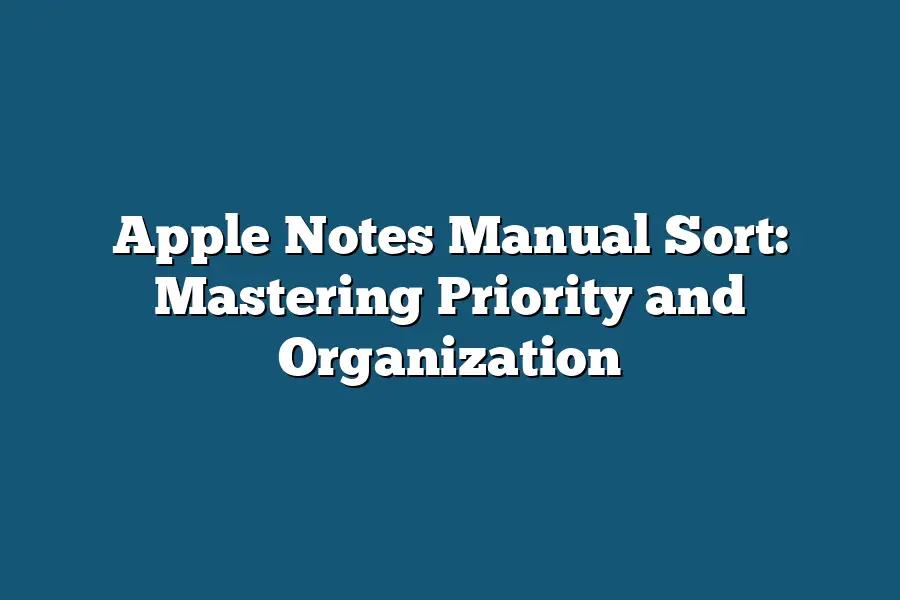In Apple Notes, you can sort your notes manually by following these steps: First, open Apple Notes on your Mac or iOS device. Then, select the note list view from the top-right corner of the window. Next, click and hold on the “Sort” button located at the bottom of the screen, then drag it to the desired sorting option (e.g., Alphabetize, Date Modified, etc.). Finally, release the mouse button to apply the sort.
As someone who’s spent years mastering the art of productivity, I’ve come to realize that the key to unlocking true success lies not in the tools we use, but in our ability to prioritize and organize.
And let me tell you, Apple Notes has been a game-changer for me – a powerful ally in my quest to stay focused and achieve my goals.
But, as anyone who’s ever tried to tame the digital jungle knows, it’s all too easy to get bogged down in the weeds of disorganization.
That’s why I’m excited to share my top tips and tricks for mastering priority and organization within Apple Notes.
From flags to favorites, and from sharing to searching, I’ll be diving into the nitty-gritty details that will transform your note-taking experience – and help you stay on track towards achieving what matters most.
Table of Contents
The Importance of Prioritizing Tasks
Let me tell you a secret to getting more done in less time: prioritizing your tasks.
Yep, it’s that simple.
When you prioritize your tasks, you’re basically telling yourself what matters most – and focusing on those things first.
It’s like having a superpower for your productivity.
I’m sure you’ve experienced it before: you sit down to tackle that big project, only to find yourself getting sidetracked by email, social media, or a random internet rabbit hole.
Sound familiar?
Prioritizing your tasks can help you avoid all that and make progress towards your goals.
So, how do you prioritize your tasks effectively?
Well, it’s not about trying to fit everything in; it’s about identifying the most critical tasks that will drive the biggest results.
Here are some examples:
Set Deadlines for Tasks
Have you ever noticed how having a deadline can help you stay focused on a task?
It’s like your brain is saying, “Alright, I’ve got this much time to get it done – let’s make it happen!” By setting deadlines for tasks, you’re giving yourself a sense of urgency and motivation to tackle them.
Break Down Large Projects into Smaller Ones
We’ve all been there: staring at a massive project with no idea where to start.
That’s when breaking it down into smaller, manageable chunks comes in handy.
This approach not only helps you avoid feeling overwhelmed but also allows you to celebrate small wins along the way – which can be super motivating.
Avoid Multitasking (Yes, You Read That Right!)
Now, I know what you’re thinking: “But I’m a multitasker extraordinaire!” While it’s true that some people are naturally better at handling multiple tasks at once, research suggests that this approach can actually decrease productivity and increase stress.
By focusing on one task at a time, you’ll be amazed at how much more efficiently you can complete them.
So, the next time you’re feeling overwhelmed by your to-do list, remember: prioritizing your tasks is key to staying focused and making progress towards your goals.
By setting deadlines, breaking down large projects, and avoiding multitasking, you’ll be well on your way to mastering priority and organization – just like Apple Notes manual sort.
Mastering Priority in Apple Notes: Tips and Tricks to Stay Organized
Are you tired of feeling like a hot mess when it comes to prioritizing your tasks in Apple Notes?
Do you find yourself constantly scrambling to keep track of what needs to be done, and when?
Well, fear not!
As someone who’s also struggled with staying organized, I’m here to share some top tips for mastering priority in Apple Notes.
And trust me, once you’ve got these strategies down pat, you’ll be flying high in no time!
Using Flags to Highlight Priority Tasks
One of the most powerful features in Apple Notes is the ability to use flags to highlight priority tasks.
By applying a flag to a specific note or group of notes, you can quickly identify which ones need attention first.
And let me tell you, there’s nothing quite like the feeling of crossing off a completed task and seeing that beautiful little flag disappear!
To use flags in Apple Notes, simply select the text you want to highlight, and then click on the “Flag” icon in the toolbar (or press ⌘ + Shift + F).
You can choose from a range of different flags, each with its own unique color and meaning.
For example, I like to use red for urgent tasks that need immediate attention, yellow for important but non-urgent tasks, and green for completed tasks.
Creating Separate Notebooks or Sections for Different Types of Tasks
Another super helpful strategy for staying organized is to create separate notebooks or sections for different types of tasks.
This way, you can keep all your work-related notes in one place, and your personal notes in another.
And let’s be real, who doesn’t love having a dedicated space for their favorite hobby or project?!
In Apple Notes, you can create new notebooks by clicking on the “File” menu and selecting “New Notebook.” Then, simply give your notebook a name (e.g., “Work”) and start adding notes!
You can also use tags to categorize your notes within each notebook.
For example, if you’re working on a project, you might tag all the relevant notes with #projectname.
Utilizing the “Share” Feature to Collaborate with Others
One of the most underrated features in Apple Notes is the ability to share your notes with others.
This way, you can collaborate with colleagues or friends, and even track progress together!
And let me tell you, there’s nothing quite like feeling like part of a team when you’re working on a project.
To share an Apple Note, simply select the note you want to share, click on the “Share” icon in the toolbar (or press ⌘ + Shift + S), and choose your sharing options.
You can share notes via email, Messages, or even AirDrop!
And don’t worry about security – Apple Notes has got your back with its robust encryption and two-factor authentication.
Tips for Mastering Priority in Apple Notes
So, now that you know some of the top strategies for mastering priority in Apple Notes, let’s talk tips!
Here are a few more ways to take your note-taking game to the next level:
- Color-code notes by priority level: Use different colors to highlight urgent tasks (red), important but non-urgent tasks (yellow), and completed tasks (green).
- Use tags for specific projects: Keep all your project-related notes organized with custom tags. For example, #projectname.
- Set reminders for upcoming deadlines: Don’t let deadlines sneak up on you! Set reminders in Apple Notes to stay on track.
And there you have it – a comprehensive guide to mastering priority in Apple Notes!
With these tips and tricks under your belt, you’ll be well on your way to becoming the ultimate note-taking master.
Happy note-taking, friends!
Best Practices for Organization in Apple Notes: Mastering Priority and Organization
As a productivity enthusiast, I’ve found that keeping my notes organized is crucial to staying on top of tasks and projects.
And with Apple Notes, you can achieve just that!
In this section, we’ll dive into some best practices for organization in Apple Notes, covering everything from creating consistent naming conventions to using keyboard shortcuts to boost your note-taking game.
Consistent Naming Conventions: The Foundation of Organization
Let’s face it – a cluttered notebook with random notes and tags can be overwhelming.
To avoid this, I recommend establishing a consistent naming convention for both notebooks and tags.
This simple habit will save you hours in the long run by making it easy to find specific notes or tasks.
For example, if you’re working on a project called “Marketing Campaign,” consider creating a notebook with that exact name.
Then, within that notebook, create separate notes for each task, such as “Create Marketing Materials” and “Develop Social Media Strategy.” By doing so, you’ll be able to quickly locate any note related to the campaign.
The Power of Search: Finding What You Need in an Instant
Speaking of finding specific notes or tasks, Apple Notes’ search function is a game-changer.
With it, you can quickly locate a particular note by searching for keywords, tags, or even phrases within the text.
For instance, if you’re on a deadline to finish a project and need to find that one note with the due date, simply type in the keyword “due date” and voilà!
The search function will instantly take you to that specific note.
This feature saves you time and reduces frustration when trying to locate information.
Favorites: Your Go-To Notes for Quick Access
Another often-overlooked feature in Apple Notes is the “Favorites” section.
By designating frequently used notes as favorites, you can quickly access them whenever you need to – without having to sift through a sea of notebooks and tags.
Think about it like this: if you have a few essential notes that you refer to daily or weekly, consider adding them to your Favorites list.
This way, when you need to review those notes, they’ll be just a tap away.
No more digging through notebooks or scrolling endlessly – with Favorites, you can stay focused on the task at hand.
Custom Templates: Streamlining Your Note-Taking Process
Apple Notes also allows you to create custom templates for your notes, which is incredibly helpful when working on repetitive tasks or projects.
By setting up a template with pre-filled information, such as dates, headings, and bullet points, you’ll be able to quickly generate high-quality notes without having to start from scratch.
For example, if you’re creating a meeting note, consider setting up a template with the following fields: Date, Meeting Topic, Attendees, Agenda Items, and Action Items.
This way, whenever you need to take a meeting note, you can simply fill in the blanks instead of starting from an empty page.
It’s all about streamlining your process!
Tips for Setting Up Your Note-Taking System
Now that we’ve covered some best practices for organization in Apple Notes, let’s dive into some additional tips for setting up your note-taking system:
- Set up a centralized hub: Designate one notebook or tag as your central hub. This will help you keep track of all your notes and projects.
- Create a naming convention for tags: Establish a consistent naming convention for your tags, such as using keywords related to the project or task.
- Use keyboard shortcuts: Take advantage of Apple Notes’ built-in keyboard shortcuts to boost your productivity (more on this below).
- Review and update regularly: Schedule regular reviews of your notes and notebooks to ensure they’re still relevant and up-to-date.
Keyboard Shortcuts: Your Key to Unlocking Productivity
Lastly, let’s talk about the power of keyboard shortcuts in Apple Notes.
By mastering these quick keys, you’ll be able to perform common actions with lightning speed – no more fumbling for the mouse or trackpad!
Some essential keyboard shortcuts include:
- ⌘ + S: Save a note
- ⌘ + N: Create a new notebook
- ⌘ + T: Tag a note
- ⌘ + Shift + F: Favorite a note
By incorporating these best practices and tips into your Apple Notes workflow, you’ll be well on your way to mastering priority and organization.
Remember, it’s all about setting up systems that work for you – so take the time to experiment and refine your approach.
That’s it for this section!
Next, we’ll dive into .
Final Thoughts
As I wrap up this guide on mastering priority and organization in Apple Notes, I’m reminded of just how powerful these tools can be when used intentionally.
By prioritizing tasks with flags, separate notebooks, and collaboration features, you can turn your notes into a reliable system for staying focused and achieving your goals.
For me, the real key to unlocking the full potential of Apple Notes has been embracing the concept of “batching” – grouping similar tasks together and completing them in one sitting.
By doing so, I’ve found that I’m able to stay in flow state for longer periods, making it easier to tackle even the most daunting projects.
As you begin implementing these strategies into your own note-taking routine, I encourage you to experiment with different techniques until you find what works best for you.
With a little creativity and intentionality, Apple Notes can become an indispensable tool in your productivity arsenal.
So go ahead, take control of your notes, and watch as your workflow becomes more streamlined and effective.


